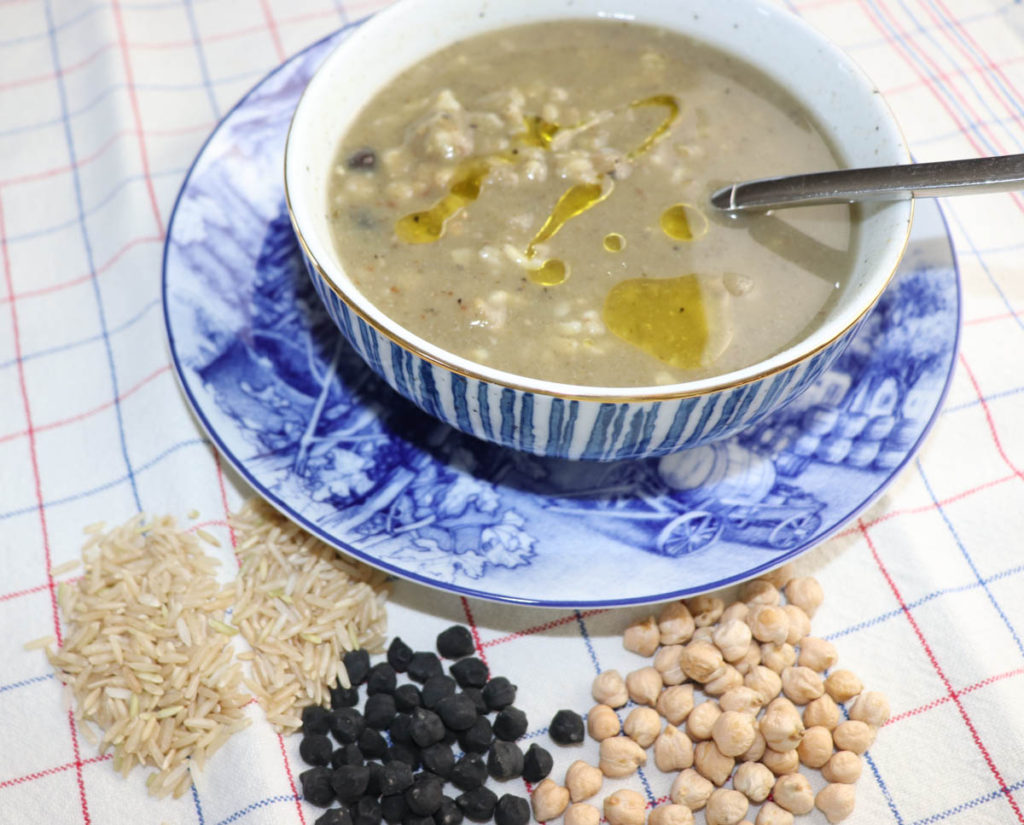During a trip to Italy, my dear friend Marisa kept praising the products of a flour mill in a nearby village so enthusiastically that we ended up making it the destination of a day trip together.
From the outside the mill didn’t look like much, but I’m used to the deceiving look of some Italian family businesses and I didn’t let the modest appearance of the premises fool me.
It took one step inside the ancient building to understand what a unique and thriving enterprise it was.The owner is the embodiment of the Italian saying “The miller’s brain turns like his mill”.
In 1955 Felice Marino took over this ancient mill from the aging Baldovino miller, already envisioning what he could make of it. Instead of modernizing it completely as many other millers were doing at that time, he decided to keep the huge round stones (each couple of stones weights 3400 lb.) and continue the ancient tradition of hammering them.
The hammering is done to keep the stones coarse in the middle and progressively smoother towards the rim, according to the type of cereal to grind, so that the flours don’t get “burned”, and their flavor is preserved.
The mill is particularly famous for grinding the “Eight-row corn” a variety of corn typical of that area of Piedmont, so called because the cob has eight rows of reddish colored grains.
The locals dubbed it “The King’s corn” because King Victor Emmanuel II was very fond of it. They still love to tell the story of La Bela Rosin (The Beautiful Rose – the King’s favorite mistress) who used to make polenta for the king when he visited her. The fact that he made his mistress Countess of Fontanafredda and Mirafiori (two huge estates) and married her after the death of Queen Adelaide, makes me think that the King didn’t travel that far just for Rose’s culinary skills.
Enough of historical gossip and let’s go back to the exceptional products of the Marino Mill.
Since 1970 the mill main activity has been the stone grinding at 80 rounds per minute (rpm), instead of the 350 rpm of the cylindrical mills that eliminate the grain germ (the part rich in proteins), its oils, B vitamins and the pericarp. Thanks to the slow-speed grinding, at Mulino Marino the grains nutrients are preserved.
All the grains milled by the Marino family (three generations work at the mill) are strictly organic – or biological, as they say in Europe – and you know how much I love this adjective!
The Marino’s require the local farmers to grow their grains for at least three years without herbicides and chemical treatments before they can become their suppliers.
The end products are flours so rich in micro-nutrients and oils that you can tell the difference from the industrial ones just by smelling them.
“This is my best advertising!” exclaimed Mr. Marino, pointing at the pinkish eight-row corn flour that was falling into a big bag. I closed my eyes to savor that wonderful, ancient smell.
If I was enthused, you should have seen my husband! He grew up helping his uncle Giovanni in the family mill, which was practically identical to the Marino Mill.
“In my uncle’s mill there was even a bell like that!” he said, showing me a little bell that signaled when all the grain was milled.
His excitement dimmed when he realized how many bags I had already piled up near the register and how greedily I was looking at the shelves full of delicious goods.
“And how do you plan to bring all that stuff with you to the United States?” he asked, trying to discourage me but already knowing that it wouldn’t work.
“I’ll put it in your suitcase, of course!” I joked. In fact, I had already eyed a sturdy cardboard box that would be perfect to carry home my purchases.
I brought home a booty of flours: white and eight-row corn, enkir, buckwheat, kamut, chestnuts (because Marisa gave me the recipe to make fettuccine with it), but also two kilos of the delicious Piedmont hazelnuts (the same that are in the original recipe of Nutella), one kilo of tiny chickpeas (because Marisa said they are outstanding) and two kilos of chickpeas flour.
We are already enjoying these wonderful products: I make Farinata with the chickpea flour (see my recipe) and we love this chickpea soup.
I must say that my friend was absolutely right: they are indeed so outstanding that, when I tasted them, they brought back memories of childhood flavors, when synthetic fertilizers didn’t force the plants grow as fast as today and they had all the time to absorb the right nutrients from the soil.
I regret not having taken any pictures but you can look up Mulino Marino website and, in their photo gallery, you will even find a picture of the bell!
Ingredients: F W V B Gf Ef
(serves 4)
- 2 cups of organic dried chickpeas
- 4 cups of water
- 3/4 cup brown long-grain rice
- 1 medium yellow potato
- 1 stalk of celery
- a few sprigs of parsley
- 1 small sprig of rosemary
- 1 carrot
- 2 ripe Roma tomatoes
- 1 clove of garlic
- ½ medium yellow onion
- 4 Tbsp. EVOO
- 1 tsp. of sea salt
- Freshly grated black pepper to taste.
Soak the chickpeas overnight in a non-metallic vessel.
The following day rinse the chickpeas and transfer them into a pot.
Peel the potato and the carrot and cut them into pieces. Wash the celery and cut it into small sections. Wash the tomatoes and cut them in two.
Peel the garlic, cut it in half, and remove its green core.
Wash the parsley and detach the leaves from the stems.
Peel the onion and add half of it to the other ingredients, cut into sections.
Transfer these ingredients into a pot, add the water and cook for 1 hour, together with the salt and the rosemary.
When the chickpeas are cooked, remove some of them with a slotted spoon and set them apart.
Add the olive oil and blend everything together with an immersion blender until you obtain a silky texture.
Bring back to a boil, add the rice and the chickpeas that you have set apart. If too much water has evaporated while cooking, add some because the rice will absorb it while coking.
You can add a Tbsp. of EVOO and some freshly ground black pepper to each bowl right before serving.
Serve hot.

